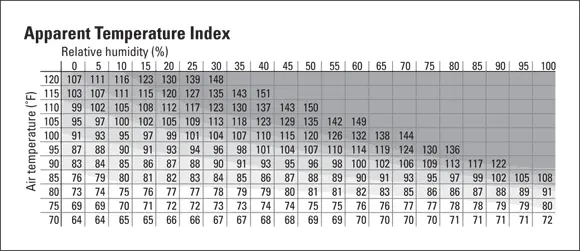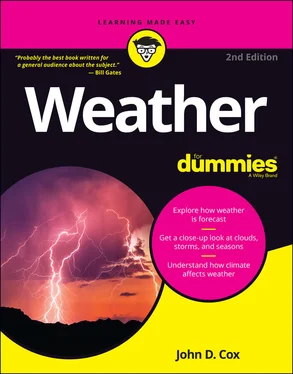1 ...8 9 10 12 13 14 ...18 Temperatures of the air are very sensitive to local conditions, such as the presence of a tree or a parking lot. The tree will keep you cooler during the day, of course, and the parking lot is hot. But these features of the landscape may have the opposite effect after dark. You may notice that the tree may actually have a warming influence on the temperature overnight, while the exposed parking lot can be especially cold. This is known as the “heat island” effect.
 Temperature ranges are generally forecast in units of 5 degrees Fahrenheit, and you commonly hear these key words used to describe them:
Temperature ranges are generally forecast in units of 5 degrees Fahrenheit, and you commonly hear these key words used to describe them:
Near , as in near 45
Around , as in around 20 degrees
About , as in about 75
Lower , as in lower 60s (60–64)
Mid , as in mid 60s (63–67)
Upper , as in upper 60s (66–69)
Forecasts of conditions beyond a couple of days are likely to use wider ranges of temperatures, calling for temperatures, for example, simply “in the 60s.”
Short-term forecasts for a specific area often are expressed in specific numbers, such as 70/52/74 to indicate a high of 70 degrees, an overnight low of 52, and a following daytime high of 74.
To avoid confusion, when temperatures get below 10 degrees or above 100, specific numbers are often used, even to express ranges. The forecast might be for a high of near 106, for example, or 102 to 108.
Temperature’s relative humidity
 The United States is a funny country. Everybody east of the Rocky Mountains is very familiar with the idea of humidity, the amount of water vapor in the air, and a lot of people west of the Rockies don’t know what all the fuss is about. ( Chapter 12explains these different climates.) Out west, when the temperatures get uncomfortably high, people console themselves with the idea that “It’s a dry heat.”
The United States is a funny country. Everybody east of the Rocky Mountains is very familiar with the idea of humidity, the amount of water vapor in the air, and a lot of people west of the Rockies don’t know what all the fuss is about. ( Chapter 12explains these different climates.) Out west, when the temperatures get uncomfortably high, people console themselves with the idea that “It’s a dry heat.”
When it comes to the human body’s comfort zone, the temperature of the air around it is only part of the story. A summer day when the maximum temperature hits 95 degrees in Sacramento, California, for example, is a very different experience than a summer day when it reaches 95 degrees in Chicago or Pittsburgh. In Sacramento, you might hear people remarking about the “nice weather.” In Chicago or Pittsburgh, people are starting to get the look of disaster on their faces.
The moisture of the air — the amount of water vapor it contains — is important to how you and I feel about the temperature of the air and important to how the air behaves when it comes to making weather. Moisture determines how much more water vapor it is likely to absorb through evaporation, on one hand, and how likely it is to give up water vapor through condensation, on the other. These tendencies are often measured by a property called relative humidity.
Relative humidity is a little tricky. It is expressed as a percentage, which is easy to get, well, not quite right. When weather forecasters say the relative humidity is 40 percent, for example, they are not saying that the air contains 40 percent water, or even 40 percent water vapor. Relative humidity describes the percentage of water vapor in the air in relation to the total amount of water vapor the air can contain at that temperature. The air is 40 percent along the scale between holding absolutely no water vapor (which never happens, by the way) and holding all that it can, its point of saturation, which happens a lot.
Water vapor is an invisible gas, but you see and feel the effects of the air’s relative humidity all the time. When you take a shower, for example, you’re adding so much water vapor to the air that it is quickly saturated. Condensation is producing tiny water droplets and you’re standing in a little cloud. Step out of the shower, and you might begin to feel a little chill. You are stepping into air that is less humid, and heat is leaving your wet skin through evaporation. The heat is used to convert the liquid into the water vapor that is being absorbed into the air. The bathroom mirror is fogged up because the air up against its cooler surface has fallen to its saturation point and some of its water vapor has condensed into dew.
 Clouds form when air rises and cools to its point of saturation.
Clouds form when air rises and cools to its point of saturation.
Relative humidity on a warm day can make all the difference in how you feel. When the relative humidity of the 95-degree air is low, it is relatively easy for the body to cool itself. Perspiration seeps through the pores in the skin, and the moisture easily evaporates into the air. Heat energy burned up in changing the water from liquid to vapor leaves the body’s temperature cooler. When the relative humidity of the 95-degree air is high, however, it really doesn’t want to take up much more water vapor, thank you, so it is much harder for the body to get rid of its heat and its perspiration. So the heat builds up, the perspiration accumulates, and the poor body, well, it just kind of stews.
The National Weather Service’s Heat Index, shown in Figure 2-1, shows apparent temperature values — the temperature that the body actually feels — which is more important than simply the heat or the humidity of the air. It is not just the heat or just the humidity, but both of these properties that this index combines to more accurately reflect what your body is going to have to cope with. The numbers in the index are based on shady, light wind conditions. Full sunshine exposure can raise these numbers by as much as 15 degrees Fahrenheit.

FIGURE 2-1:This Heat Index was devised by the National Weather Service to show the temperature the body feels when the heat and humidity are combined.
 Here are some valuable health guidelines from the National Weather Service:
Here are some valuable health guidelines from the National Weather Service:
Between 80 degrees and 90 degrees on the Heat Index, be on the lookout for signs of fatigue with prolonged exposure or physical activity.
Between 90 degrees and 105 degrees, with prolonged exposure or physical activity, you may experience sunstroke, heat cramps, or heat exhaustion.
Between 105 degrees and 130 degrees, you are likely to experience sunstroke, heat cramps, or heat exhaustion.
At 130 degrees or above, dangerous conditions of heat stroke or sunstroke are highly likely with continued exposure.
The world of weather has two main ways of measuring the temperature of the air (and the temperature of water, for that matter). The Fahrenheit (F) scale is used in the United States; the Celsius (C) scale is used in much of the rest of the world, including Europe and Canada.
In 1714, German physicist Gabriel Daniel Fahrenheit developed a scale where water boils at 212 degrees (F) and freezes at 32 degrees (F).
In 1742, Swedish astronomer Anders Celsius devised a scale in which the melting point of ice is designated zero degrees (C), and the boiling point of water is 100 degrees (C).
This figure is a handy comparison of the two scales.
Читать дальше

 Temperature ranges are generally forecast in units of 5 degrees Fahrenheit, and you commonly hear these key words used to describe them:
Temperature ranges are generally forecast in units of 5 degrees Fahrenheit, and you commonly hear these key words used to describe them: The United States is a funny country. Everybody east of the Rocky Mountains is very familiar with the idea of humidity, the amount of water vapor in the air, and a lot of people west of the Rockies don’t know what all the fuss is about. ( Chapter 12explains these different climates.) Out west, when the temperatures get uncomfortably high, people console themselves with the idea that “It’s a dry heat.”
The United States is a funny country. Everybody east of the Rocky Mountains is very familiar with the idea of humidity, the amount of water vapor in the air, and a lot of people west of the Rockies don’t know what all the fuss is about. ( Chapter 12explains these different climates.) Out west, when the temperatures get uncomfortably high, people console themselves with the idea that “It’s a dry heat.”











